Global Investigation of Wind–Wave Interaction Using Spaceborne SAR Measurements
Abstract
1. Introduction
2. Data and Methods
2.1. Envisat/ASAR Wave Mode
2.2. MACS Profile and Range Peak Wavenumber
3. Results and Discussion
3.1. Global Characteristics of SAR-Derived iwa
3.2. Local Variation in iwa
3.3. Analysis of Wind–Wave Interaction
4. Conclusions
Author Contributions
Funding
Institutional Review Board Statement
Informed Consent Statement
Data Availability Statement
Acknowledgments
Conflicts of Interest
References
- Toba, Y. Local balance in the air-sea boundary processes. J. Oceanogr. 1972, 28, 109–120. [Google Scholar] [CrossRef]
- Phillips, O.M. The Dynamics of the Upper Ocean, 2nd ed.; Cambridge University Press: Cambridge/London, UK; New York, NY, USA; Melbourne, Australia, 1977. [Google Scholar]
- Hasselmann, K.; Barnett, T.; Bouws, E.; Carlson, H.; Cartwright, D.; Enke, K.; Ewing, J.; Gienapp, H.; Hasselmann, D.; Kruseman, P.; et al. Measurements of wind-wave growth and swell decay during the Joint North Sea Wave Project (JONSWAP). In Part of Collection: Hydraulic Engineering Reports A(8), 12; Deutches Hydrographisches Institut: Hamburg, Germany, 1973. [Google Scholar]
- Sterl, A.; Komen, G.J.; Cotton, P.D. Fifteen years of global wave hindcasts using winds from the European Centre for Medium-Range Weather Forecasts reanalysis: Validating the reanalyzed winds and assessing the wave climate. J. Geophys. Res. Ocean. 1998, 103, 5477–5492. [Google Scholar] [CrossRef]
- Young, I. Seasonal variability of the global ocean wind and wave climate. Int. J. Climatol. 1999, 19, 931–950. [Google Scholar] [CrossRef]
- Wang, X.L.; Zwiers, F.W.; Swail, V.R. North Atlantic Ocean Wave Climate Change Scenarios for the Twenty-First Century. J. Clim. 2004, 17, 2368–2383. [Google Scholar] [CrossRef]
- Li, X.; Lehner, S.; Bruns, T. Ocean Wave Integral Parameter Measurements Using Envisat ASAR Wave Mode Data. IEEE Trans. Geosci. Remote Sens. 2011, 49, 155–174. [Google Scholar] [CrossRef]
- Young, I.R.; Zieger, S.; Babanin, A.V. Global Trends in Wind Speed and Wave Height. Science 2011, 332, 451–455. [Google Scholar] [CrossRef] [PubMed]
- Young, I.R.; Ribal, A. Multiplatform evaluation of global trends in wind speed and wave height. Science 2019, 364, 548–552. [Google Scholar] [CrossRef] [PubMed]
- Hanley, K.E.; Belcher, S.E.; Sullivan, P.P. A Global Climatology of Wind–Wave Interaction. J. Phys. Oceanogr. 2010, 40, 1263–1282. [Google Scholar] [CrossRef]
- Stopa, J.E.; Cheung, K.F.; Tolman, H.L.; Chawla, A. Patterns and cycles in the Climate Forecast System Reanalysis wind and wave data. Ocean Model. 2013, 70, 207–220. [Google Scholar] [CrossRef]
- Chen, G.; Chapron, B.; Ezraty, R.; Vandemark, D. A Global View of Swell and Wind Sea Climate in the Ocean by Satellite Altimeter and Scatterometer. J. Atmos. Ocean. Technol. 2002, 19, 1849–1859. [Google Scholar] [CrossRef]
- Jiang, H.; Chen, G. A Global View on the Swell and Wind Sea Climate by the Jason-1 Mission: A Revisit. J. Atmos. Ocean. Technol. 2013, 30, 1833–1841. [Google Scholar] [CrossRef]
- Shimura, T.; Mori, N.; Mase, H. Future Projections of Extreme Ocean Wave Climates and the Relation to Tropical Cyclones: Ensemble Experiments of MRI-AGCM3.2H. J. Clim. 2015, 28, 9838–9856. [Google Scholar] [CrossRef]
- Reguero, B.G.; Losada, I.J.; Méndez, F.J. A recent increase in global wave power as a consequence of oceanic warming. Nat. Commun. 2019, 10, 205. [Google Scholar] [CrossRef]
- Portilla-Yandún, J. The Global Signature of Ocean Wave Spectra. Geophys. Res. Lett. 2018, 45, 267–276. [Google Scholar] [CrossRef]
- Portilla-Yandún, J.; Salazar, A.; Cavaleri, L. Climate patterns derived from ocean wave spectra. Geophys. Res. Lett. 2016, 43, 11736–11743. [Google Scholar] [CrossRef]
- Collard, F.; Ardhuin, F.; Chapron, B. Monitoring and analysis of ocean swell fields from space: New methods for routine observations. J. Geophys. Res. Ocean. 2009, 114, 1–15. [Google Scholar] [CrossRef]
- Stopa, J.E.; Ardhuin, F.; Husson, R.; Jiang, H.; Chapron, B.; Collard, F. Swell dissipation from 10 years of Envisat advanced synthetic aperture radar in wave mode. Geophys. Res. Lett. 2016, 43, 3423–3430. [Google Scholar] [CrossRef]
- Ardhuin, F.; Collard, F.; Chapron, B.; Girard-Ardhuin, F.; Guitton, G.; Mouche, A.; Stopa, J.E. Estimates of ocean wave heights and attenuation in sea ice using the SAR wave mode on Sentinel-1A. Geophys. Res. Lett. 2015, 42, 2317–2325. [Google Scholar] [CrossRef]
- Stopa, J.E.; Sutherland, P.; Ardhuin, F. Strong and highly variable push of ocean waves on Southern Ocean sea ice. Proc. Natl. Acad. Sci. USA 2018, 115, 5861–5865. [Google Scholar] [CrossRef]
- Li, X.M. A new insight from space into swell propagation and crossing in the global oceans. Geophys. Res. Lett. 2016, 43, 5202–5209. [Google Scholar] [CrossRef]
- Li, H.; Chapron, B.; Mouche, A.; Stopa, J.E. A New Ocean SAR Cross-Spectral Parameter: Definition and Directional Property Using the Global Sentinel-1 Measurements. J. Geophys. Res. Ocean. 2019, 124, 1566–1577. [Google Scholar] [CrossRef]
- Li, H.; He, Y.; Wang, C.; Lin, W.; Yang, J. Study of global ocean waves based on SAR image cross-spectrum. Haiyang Xuebao 2023, 46, 1–7. (In Chinese) [Google Scholar]
- Hasselmann, K.; Chapron, B.; Aouf, L.; Ardhuin, F.; Collard, F.; Engen, G.; Hasselmann, S.; Heimbach, P.; Janssen, P.; Johnsen, H.; et al. The ERS SAR Wave Mode—A Breakthrough in global ocean wave observations. In ERS Missions—20 Years of Observing Earth; European Space Agency: Paris, France, 2012. [Google Scholar]
- Johnsen, H. ENVISAT ASAR Wave Mode Product Description and Reconstruction Procedure. In Technical Report 1/2005; Norut: Tromso, Norway, 2005. [Google Scholar]
- Escobar, C.A.; Restrepo Alvarez, D. Estimation of global ocean surface winds blending reanalysis, satellite and buoy datasets. Remote Sens. Appl. Soc. Environ. 2023, 32, 101012. [Google Scholar] [CrossRef]
- Zhao, K.; Zhao, C. Evaluation of HY-2A Scatterometer Ocean Surface Wind Data during 2012–2018. Remote Sens. 2019, 11, 2968. [Google Scholar] [CrossRef]
- Ribal, A.; Young, I.R. Global Calibration and Error Estimation of Altimeter, Scatterometer, and Radiometer Wind Speed Using Triple Collocation. Remote Sens. 2020, 12, 1997. [Google Scholar] [CrossRef]
- Engen, G.; Johnsen, H. SAR-ocean wave inversion using image cross spectra. IEEE Trans. Geosci. Remote Sens. 1995, 33, 1047–1056. [Google Scholar] [CrossRef]
- Chapron, B.; Johnsen, H.; Garello, R. Wave and wind retrieval from sar images of the ocean. Ann. Télécommun. 2001, 56, 682–699. [Google Scholar] [CrossRef]
- Schulz-Stellenfleth, J.; König, T.; Lehner, S. An empirical approach for the retrieval of integral ocean wave parameters from synthetic aperture radar data. J. Geophys. Res. Ocean. 2007, 112, 1–14. [Google Scholar] [CrossRef]
- Stopa, J.E.; Mouche, A. Significant wave heights from Sentinel-1 SAR: Validation and applications. J. Geophys. Res. Ocean. 2017, 122, 1827–1848. [Google Scholar] [CrossRef]
- Elfouhaily, T.; Chapron, B.; Katsaros, K.; Vandemark, D. A unified directional spectrum for long and short wind-driven waves. J. Geophys. Res. Ocean. 1997, 102, 15781–15796. [Google Scholar] [CrossRef]
- Jiang, H.; Chen, G.; Yu, F. An index of wind–wave coupling and its global climatology. Int. J. Climatol. 2016, 36, 3139–3147. [Google Scholar] [CrossRef]
- Hwang, P.A. Duration- and fetch-limited growth functions of wind-generated waves parameterized with three different scaling wind velocities. J. Geophys. Res. Ocean. 2006, 111, 1–10. [Google Scholar] [CrossRef]
- Young, I.; Vinoth, J. An “extended fetch” model for the spatial distribution of tropical cyclone wind–waves as observed by altimeter. Ocean Eng. 2013, 70, 14–24. [Google Scholar] [CrossRef]
- Kudryavtsev, V.; Yurovskaya, M.; Chapron, B. Self-Similarity of Surface Wave Developments Under Tropical Cyclones. J. Geophys. Res. Ocean. 2021, 126, e2020JC016916. [Google Scholar] [CrossRef]
- Hell, M.C.; Ayet, A.; Chapron, B. Swell Generation Under Extra-Tropical Storms. J. Geophys. Res. Ocean. 2021, 126, e2021JC017637. [Google Scholar] [CrossRef]
- Janssen, P.A.E.M.; Viterbo, P. Ocean Waves and the Atmospheric Climate. J. Clim. 1996, 9, 1269–1287. [Google Scholar] [CrossRef]
- Hemer, M.A.; Wang, X.L.; Weisse, R.; Swail, V.R. Advancing Wind-Waves Climate Science. Bull. Am. Meteorol. Soc. 2012, 93, 791–796. [Google Scholar] [CrossRef]
- Stopa, J.E.; Ardhuin, F.; Chapron, B.; Collard, F. Estimating wave orbital velocity through the azimuth cutoff from space-borne satellites. J. Geophys. Res. Ocean. 2015, 120, 7616–7634. [Google Scholar] [CrossRef]
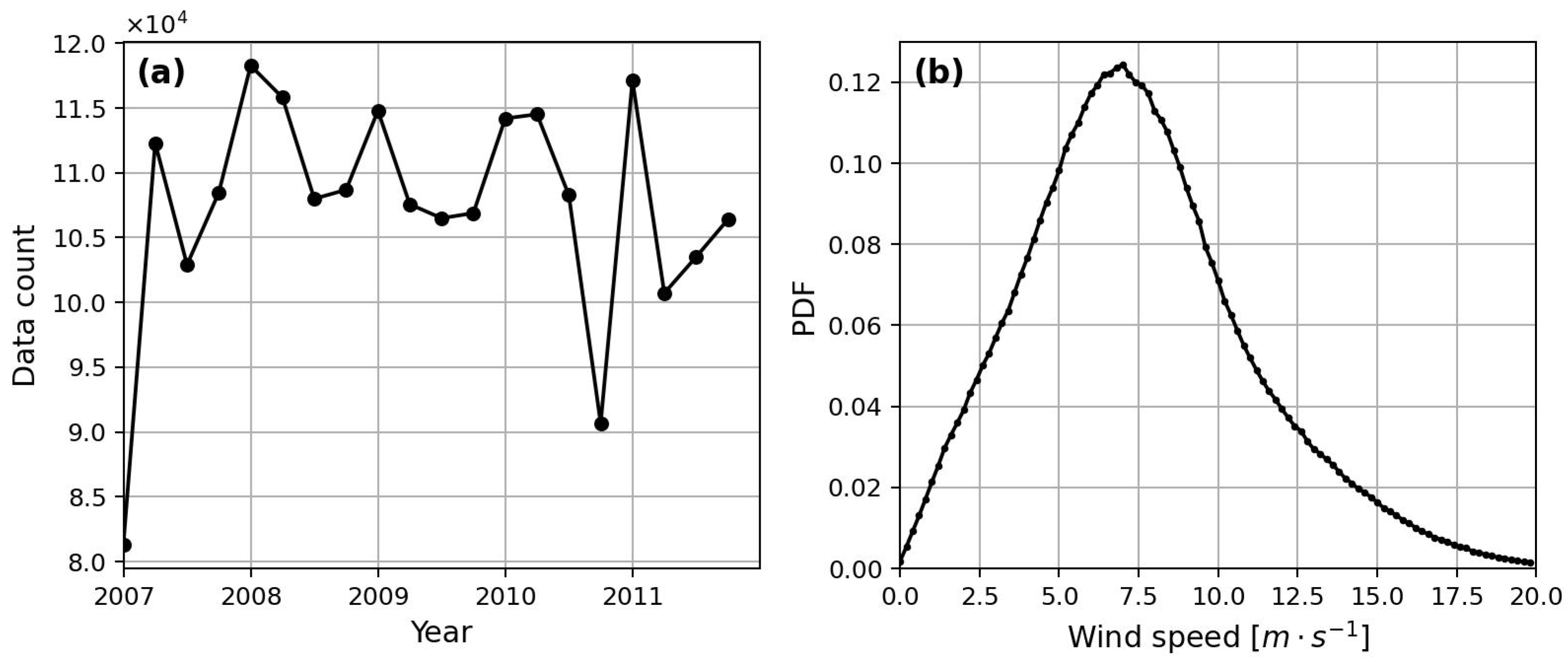
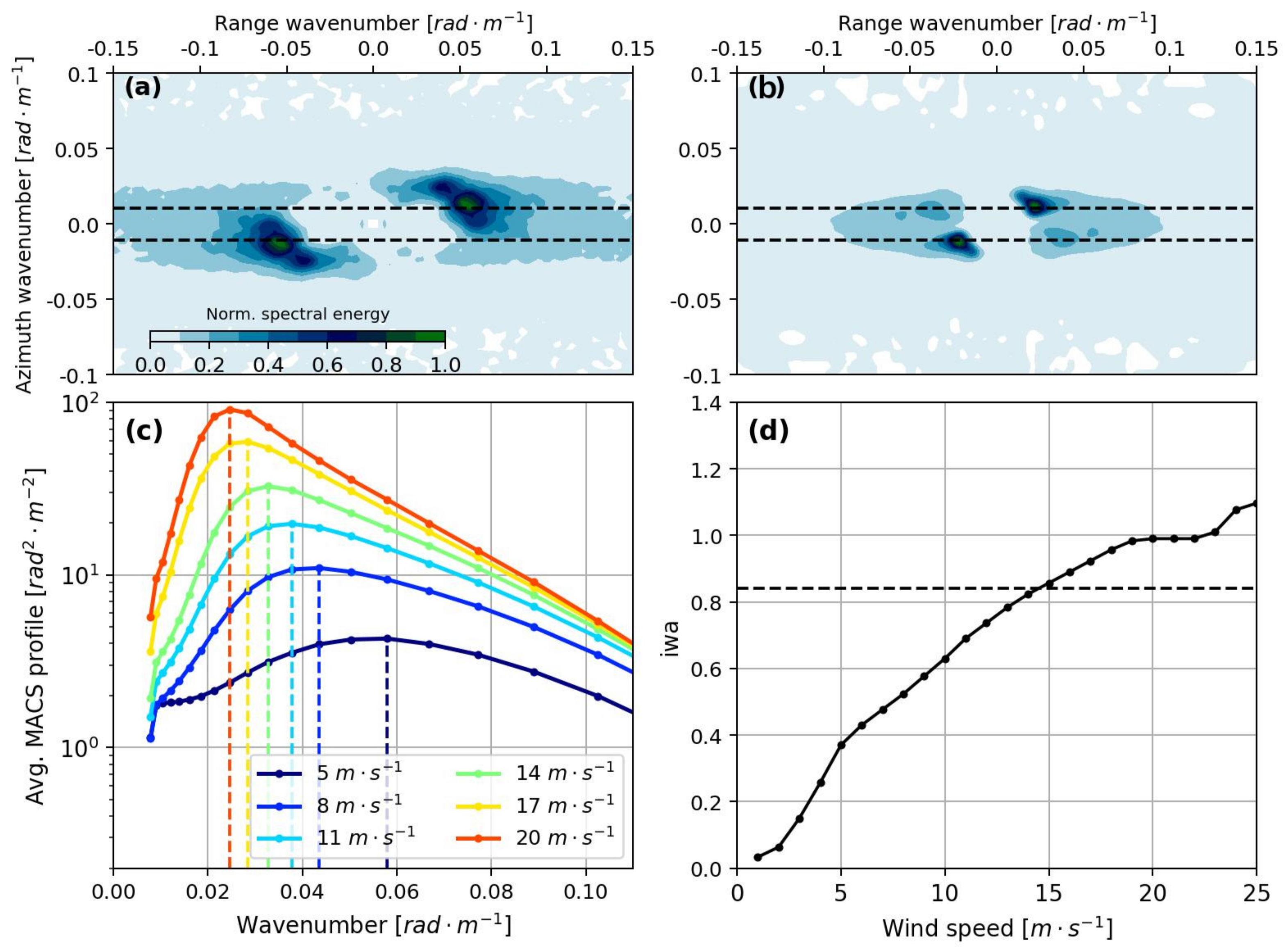
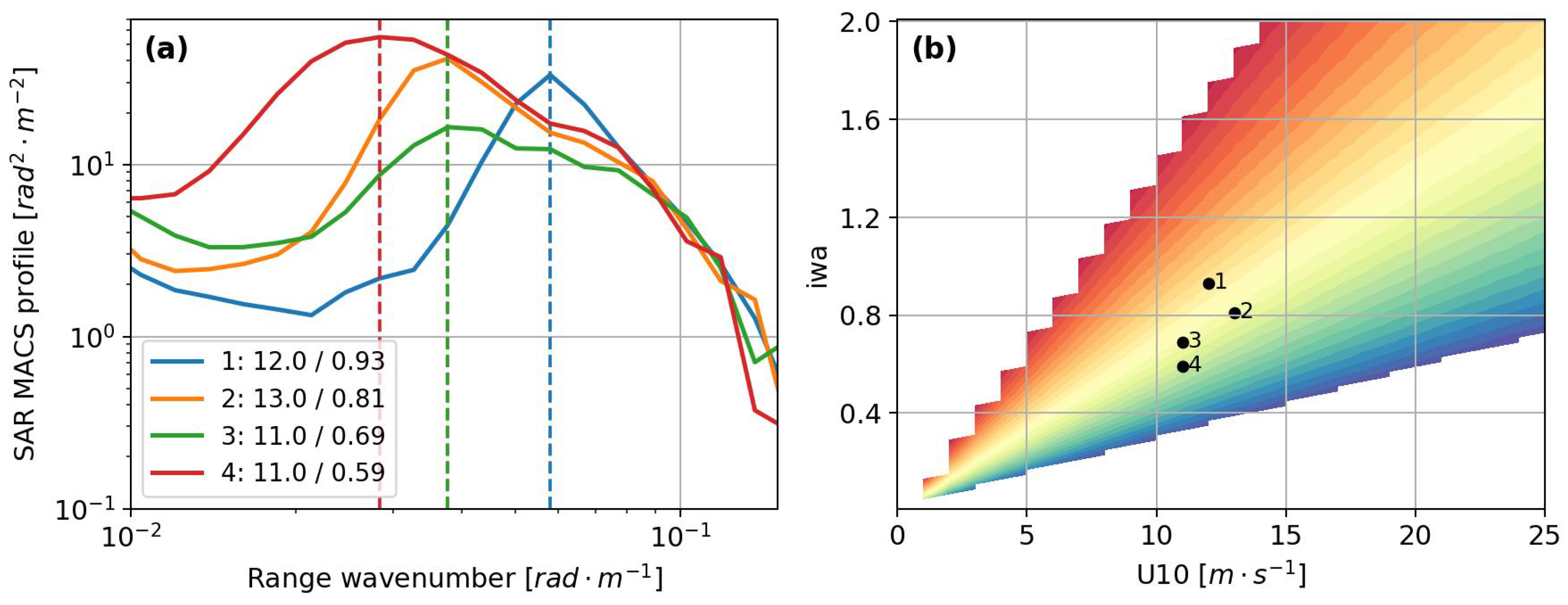
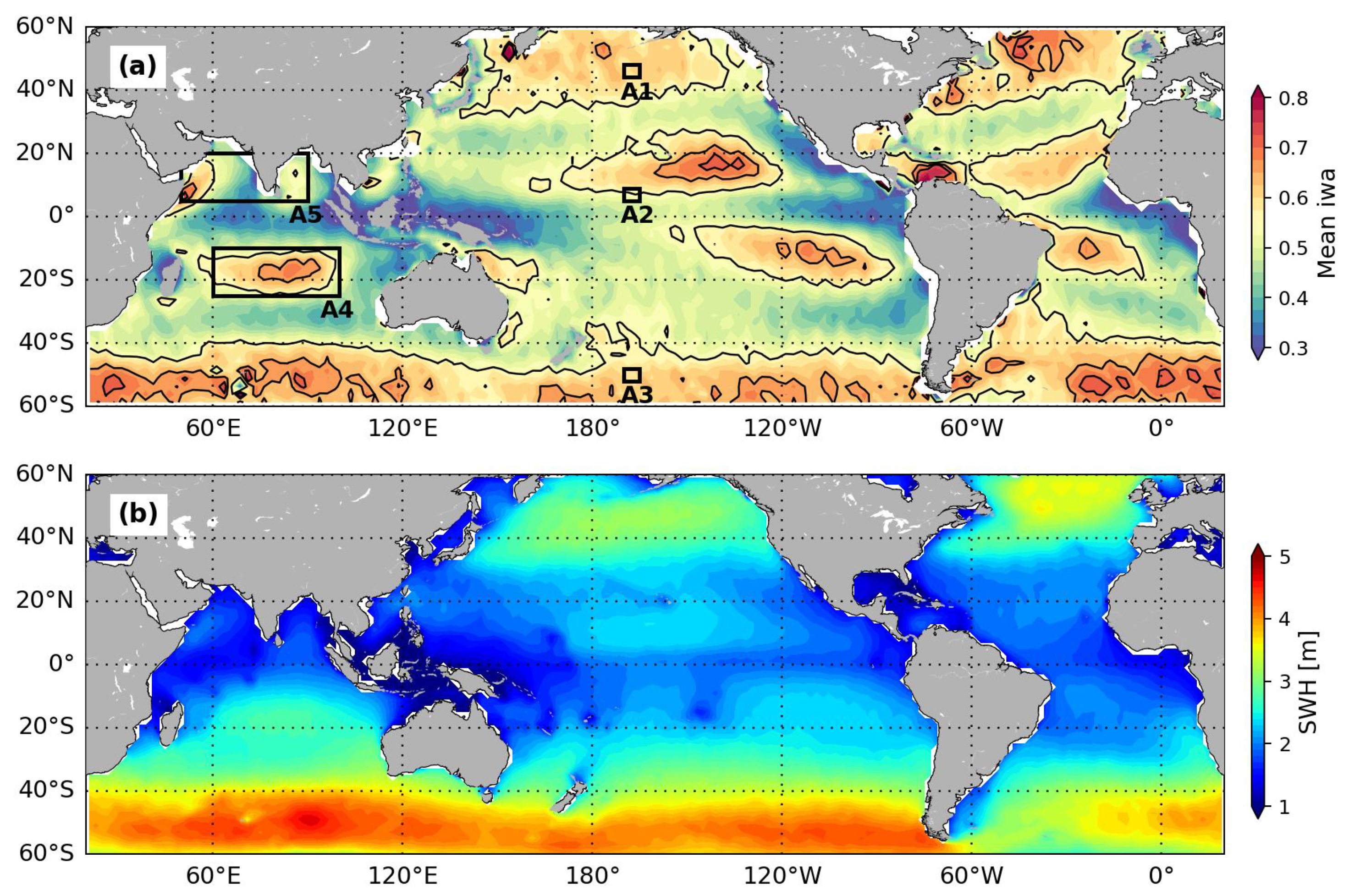



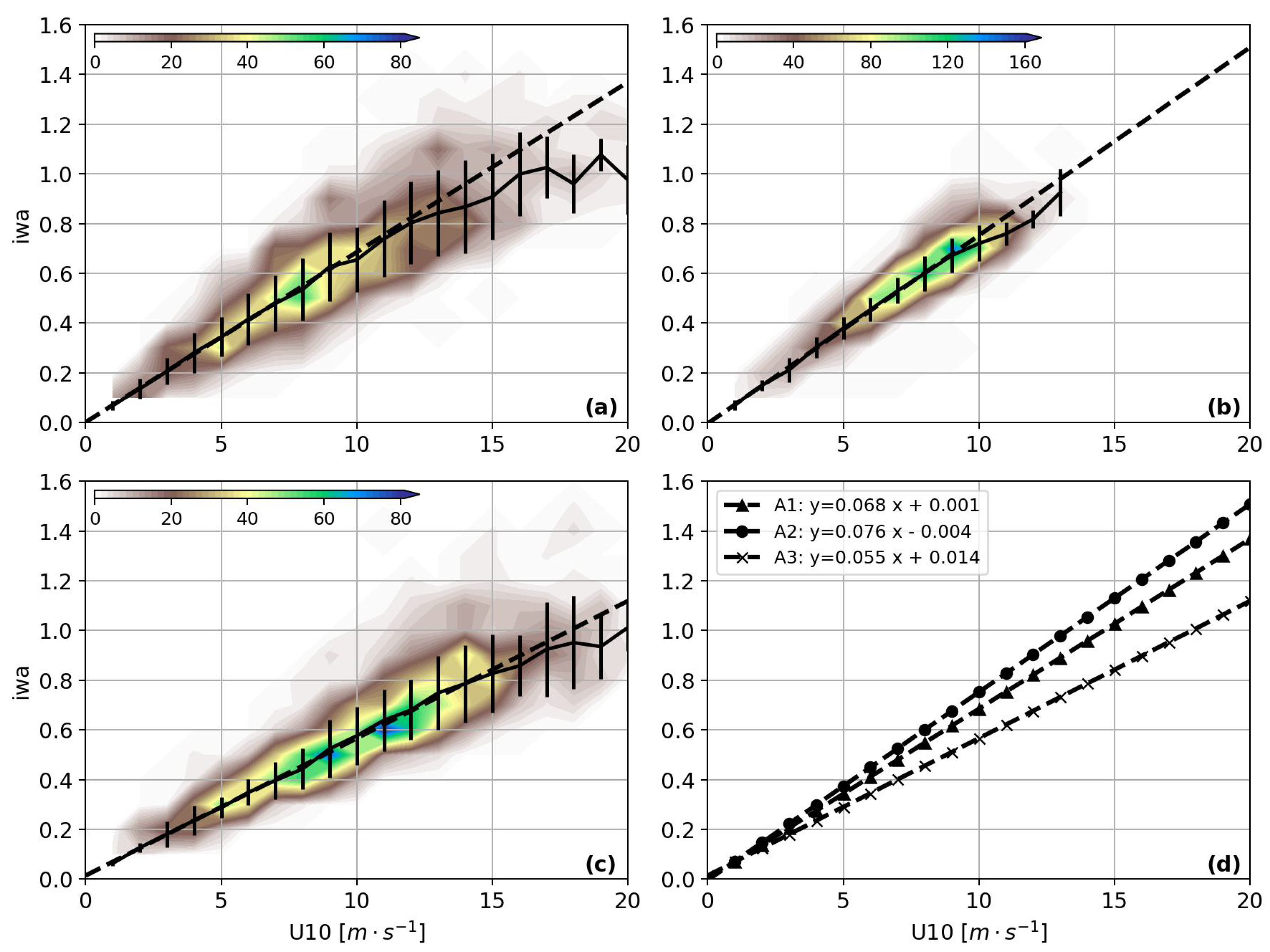

Disclaimer/Publisher’s Note: The statements, opinions and data contained in all publications are solely those of the individual author(s) and contributor(s) and not of MDPI and/or the editor(s). MDPI and/or the editor(s) disclaim responsibility for any injury to people or property resulting from any ideas, methods, instructions or products referred to in the content. |
© 2024 by the authors. Licensee MDPI, Basel, Switzerland. This article is an open access article distributed under the terms and conditions of the Creative Commons Attribution (CC BY) license (https://creativecommons.org/licenses/by/4.0/).
Share and Cite
Li, H.; He, Y. Global Investigation of Wind–Wave Interaction Using Spaceborne SAR Measurements. J. Mar. Sci. Eng. 2024, 12, 433. https://doi.org/10.3390/jmse12030433
Li H, He Y. Global Investigation of Wind–Wave Interaction Using Spaceborne SAR Measurements. Journal of Marine Science and Engineering. 2024; 12(3):433. https://doi.org/10.3390/jmse12030433
Chicago/Turabian StyleLi, Huimin, and Yijun He. 2024. "Global Investigation of Wind–Wave Interaction Using Spaceborne SAR Measurements" Journal of Marine Science and Engineering 12, no. 3: 433. https://doi.org/10.3390/jmse12030433
APA StyleLi, H., & He, Y. (2024). Global Investigation of Wind–Wave Interaction Using Spaceborne SAR Measurements. Journal of Marine Science and Engineering, 12(3), 433. https://doi.org/10.3390/jmse12030433





